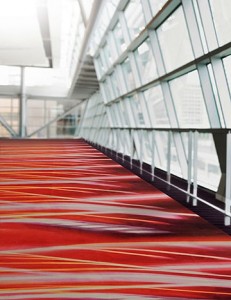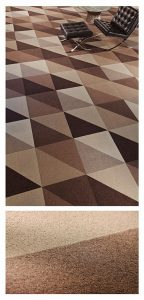
By Ronald E. Keener

Today’s carpet can be made from recycled materials, and are readily recycled at the end of their lifespan.
Some things don’t change much when it comes to choosing carpet for the church.
The color of the sanctuary’s stage carpet and the runner up the middle aisle more often might be determined by the pastor’s wife or the favorite football team, says Bear Goolsby of Powers Goolsby Architects, Universal City, TX, which has a number of church clients in 48 states.
Still, other things are changing. “Eco-friendly carpets have really come to the front,” Goolsby says. “Not only are many carpet fibers and backings made from recycled materials, but they are designed to be readily recycled at the end of their lifespan. Stain resistance in carpet has greatly improved due to the dying process and you can even find some carpet with a polarity charged fiber that is designed to resist coffee stains.”
The people at the well-known Milliken floor covering division pride themselves on offering unlimited customization options. “Through a unique blend of science and design, our floor covering collections help the architecture and design industry achieve inspiring design solutions,” says Milliken’s Bob Baird, general manager of global commercial carpet.
Baird says that floor coverings are chosen on the basis of function, aesthetics and performance and “no one floor covering will fulfill all requirements.”
“Churches want carpet solutions that are architecturally consistent with their surrounding space. They want floor covering that will perform well over time and stand up to heavy traffic. They want a solution that can be easily maintained with a welcoming aesthetic and quality finish,” says Baird.
“And, they want a provider they can trust to meet their diverse floor covering needs in a timely, hassle-free manner with a seamless installation.”
Bear Goolsby says that more churches are looking at other floor coverings than carpet.
“Stained concrete has been around for a while and is very popular due to the visual appeal, durability and easy maintenance, but care must be taken to ensure proper staining and polishing,” he says.
- “Wood look, ceramic tiles are very popular for hightraffic areas. These tiles give the look of a wood floor and the durability of tile,” he adds.
- “Bamboo flooring options have also become very popular to their durability and style options. Being sustainable, many manufacturers have created several bamboo products and made it an affordable option.”
And when it comes to color, there is much beyond the usual beige from which to choose.

Says Goolsby: “We’ve moved from reds, to browns and blues to green and warm greys. If you are using a multi colored carpet, you have so many options available, from just one swatch, to pull several paint schemes.”
“Churches are asking for colors that complement the intended purpose and aesthetic for each space,” Baird agrees. “Sanctuaries should be inviting, so there is certainly a trend toward rich colors, such as dark reds and deep blues and greens. If they choose a neutral color, warm beige tones are very popular as they portray a welcoming aesthetic.
“Patterns that tend to work well in these spaces are small in design and feature motifs specifically chosen to accentuate and enhance the building’s existing architecture,” Baird says.
Goolsby says that he has clients determined to use a solid color carpet. “As great as today’s carpets are, the traffic generated by a congregation over a few years will wear down a solid-color carpet. We do our best to show people how using a patterned, multi-colored carpet will not show traffic patterns as fast; plus, the patterned carpets help to hide dirt and trouble spots that creep up in church facilities,” he says.
Building committees should decide in their selections on how well the carpet holds its color, how well it will hold up to traffic, and the availability of coordinating carpets, says Goolsby.
Milliken’s Baird says that durability and the intended use of the space determine the specific type of carpet necessary. “Sanctuaries are best suited for broadloom applications, while modular carpet is more appropriate for areas where congregations gather to share food and refreshments, as it’s easier to maintain and replace.”
When it comes to coffee and food, Goolsby says “some manufacturers recommend using vinegar to help remove coffee stains, while you can find a carpet that has looked at the molecular structure, but they have fixed the polarity of the fiber to aid in the repelling of acidic stains.”
But the best advice, he says: “We recommend asking people to leave the coffee in the lobby, and preferably where the tile is.”
Ronald E. Keener is the former editor of Church Executive Magazine. This article originally appeared in our October 2012 issue.
Dealing with those awful coffee stains
Vacuuming is the most critical component in maintaining carpet. Supplement this with spot cleaning, and use a professional cleaner on a routine basis to maintain the life and beauty of your church’s flooring.
So says Stephen Lewis, technical director for LaGrange, GA-based MilliCare, the textile and carpet care unit of Milliken Flooring. And for high traffic areas, Lewis says the answer is “vacuum, vacuum and vacuum.” “Dry soil damages carpet fibers and is the reason carpet develops wear patterns,” he says. “By removing this soil frequently, especially after a service or event, you will dramatically extend your carpet’s appearance.”

And those coffee stains? “General-purpose spot cleaners can usually remove the typical coffee stain completely,” he says. “However, decaffeinated coffee can actually ‘dye’ nylon carpet fibers, making it difficult to remove. These stains can be eliminated with spot cleaning products called reducing agents. They remove oxygen from the stain to bleach it clear and require activation with heat — often with a steam iron.”
But Lewis advises that only a trained professional should attempt this, as there is the potential to damage the carpet due to the use of heat. Oxidizing agents with hydrogen peroxide might also bleach the stain clear.
As for food stains, Lewis says that while many products claim to be all-purpose stain removers, the truth is that there is no perfect solution. “Most water-soluble cleaners will remove food related stains, but fail to eliminate grease and oily soils,” he advises. “The key is to have two or three different kinds of carpet cleaning solutions on hand to deal with a variety of stain types.”
What’s the “green” movement’s implications for carpets? “The most environmentally friendly products have third-party green certifications. Choose carpet cleaning systems that use less water and energy — but are still effective at removing soil,” Lewis says. “While these processes are considered ‘green,’ the most important thing you can do from an environmental standpoint is keep your carpet installed as long as possible. When properly maintained, commercial carpet can last for many years before having to be disposed of.”
Finally, what vacuum product works best? Lewis says to choose a commercial upright vacuum with a beater brush. These machines are the best at removing dry soil in any home or facility.


